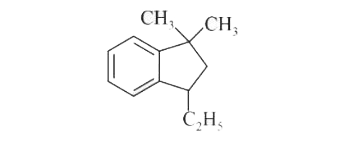The major product [B] in the following reaction is :
CH3−CH3−CH| CH−CH2−OCH2−CH3HI−−→Heat[A] alcoholH2SO4−−−→Δ[B]
CH3−CH2−CH=CH−CH3
CH2=CH2
CH3−CH=CH3| C −CH3
CH3−CH2−CH3| C =CH2
To solve the given reaction step-by-step, let's break it down into parts:
Step 1: Understand the Initial Reactants
The initial reactants are:
- An alcohol: CH3−CH2−CH(CH2−OCH2−CH3).
- Hydrogen iodide (HI) and heat.
Step 2: Reaction with HI
When the alcohol reacts with HI, the hydroxyl group (OH) is protonated, making it a better leaving group. The iodine ion (I-) will then attack the carbon atom bonded to the hydroxyl group, leading to the formation of a carbocation.
1. Protonation of the alcohol:
- The oxygen in the alcohol gets protonated by HI, forming a good leaving group (water).
2. Leaving group departs:
- The water molecule leaves, resulting in a carbocation at the adjacent carbon.
Step 3: Carbocation Rearrangement
The carbocation formed can undergo rearrangement to form a more stable carbocation. In this case, a 1-degree carbocation can rearrange to a more stable 3-degree carbocation.
1. Identify the stability of carbocations:
- The carbocation will rearrange to the more stable form (3-degree) by shifting a hydrogen atom from an adjacent carbon.
Step 4: Nucleophilic Attack
Once the more stable carbocation is formed, the iodide ion (I-) from HI can attack this carbocation.
1. Iodine attacks the carbocation:
- This results in the formation of an alkyl iodide.
Step 5: Dehydration Reaction with H2SO4
The alkyl iodide can then react with sulfuric acid (H2SO4) upon heating, leading to dehydration.
1. Removal of water:
- The reaction with H2SO4 leads to the elimination of a water molecule, forming a double bond.
Step 6: Formation of the Major Product
The final product after dehydration is an alkene.
1. Write the structure of the final product:
- The major product (B) will be an alkene with the structure CH3−CH=CH−CH3.
Final Answer
The major product (B) in the reaction sequence is an alkene, specifically 2-butene.
---
The initial reactants are:
- An alcohol: CH3−CH2−CH(CH2−OCH2−CH3).
- Hydrogen iodide (HI) and heat.
When the alcohol reacts with HI, the hydroxyl group (OH) is protonated, making it a better leaving group. The iodine ion (I-) will then attack the carbon atom bonded to the hydroxyl group, leading to the formation of a carbocation.
- The oxygen in the alcohol gets protonated by HI, forming a good leaving group (water).
2. Leaving group departs:
- The water molecule leaves, resulting in a carbocation at the adjacent carbon.
The carbocation formed can undergo rearrangement to form a more stable carbocation. In this case, a 1-degree carbocation can rearrange to a more stable 3-degree carbocation.
- The carbocation will rearrange to the more stable form (3-degree) by shifting a hydrogen atom from an adjacent carbon.
Once the more stable carbocation is formed, the iodide ion (I-) from HI can attack this carbocation.
- This results in the formation of an alkyl iodide.
The alkyl iodide can then react with sulfuric acid (H2SO4) upon heating, leading to dehydration.
- The reaction with H2SO4 leads to the elimination of a water molecule, forming a double bond.
The final product after dehydration is an alkene.
- The major product (B) will be an alkene with the structure CH3−CH=CH−CH3.
The major product (B) in the reaction sequence is an alkene, specifically 2-butene.
Topper's Solved these Questions
Similar Questions
Complete the following reactions:
(i) CH3−CH2−O−CH3| C | CH3−CH3−HIHeat−−→
View SolutionIdentify the compound 'D' in the following series of reaction.
CH3−CH3| CH−CH2−CH2−BrAlc. KOH−−−−−→Δ'A'(i) Conc. H2SO4−−−−−−−−−→(ii) H2O,Δ'B'Majorproduct+'C'Minorproduct
'B'Hl,Δ−−−→−H2O'D'(Majorproduct)+'E'(Minorproduct)
View Solution
Knowledge Check
The major product P in the following reaction is CH3CH=CH2HI−−−−→PeroxideP
ACH3CH2CH2IBCH3−CHI−CH3CICH2−CH=CH2DICH2−CH2IThe major product of the following equation is.
C2H5−CH3| C | Ph−CH2−CH| OH−CH3conc. H2SO4−−−−−−−→ΔA B
B C
C D
D
The major product of the following reaction is
CH3−CH3∣C∣OH−CH2−OHH2SO4−−−→A(CH3)2C=CH2BButan -2-oneC(CH3)2OH∣C−CHODIsobutyraldehyde
The major product of the following reaction is
CH3−CH3∣C∣OH−CH2−OHH2SO4−−−→
View SolutionThe major product formed in the reaction is:
CH3−CH3∣C∣H−CH2BrCH3OӨ−−−−→CH3OH
View SolutionThe major product of the following reaction is
CH3−CH3| C | OH−CH2H2SO4−−−→| OH
View SolutionIdentify the compound 'D' in the following series of reactions .
CH3−CH3∣CH−CH2−CH2−Bralc.KOH−−−−−−→Δ'A'(i) Conc.H2SO4−−−−−−−−−−→(ii)H2O,Δ'D'(Major product)+'C'(Minor product)'B'HI,Δ−−−−−−→−H2O'D'(Major product)+(Minor product)
View SolutionIdentify the compound 'D' in the following series of reactions .
CH3−CH3∣CH−CH2−CH2−Bralc.KOH−−−−−−→Δ'A'(i) Conc.H2SO4−−−−−−−−−−→(ii)H2O,Δ'D'(Major product)+'C'(Minor product)'B'HI,Δ−−−−−−→−H2O'D'(Major product)+(Minor product)
View Solution
